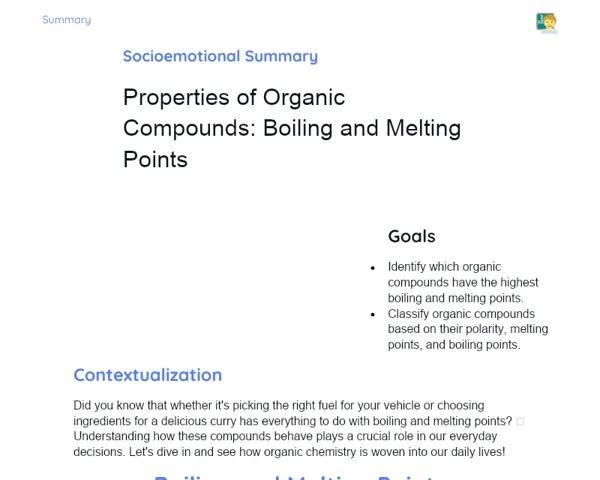Summary Tradisional | Introduction to Organic Chemistry: Chain Classification
Contextualization
Organic Chemistry is a vital branch of chemistry that focuses on studying carbon compounds, which are essential for life and are a part of our everyday environment. From the food we eat to the medications we rely on, organic compounds play a crucial role in our lives. This field of chemistry is fundamental for grasping the structure, properties, and reactions of these compounds, paving the way for significant advancements in science and technology.
Classifying carbon chains is a vital aspect of Organic Chemistry as it helps identify and arrange compounds based on their structures. Carbon chains can either be open or closed, saturated or unsaturated, homogeneous or heterogeneous, among various other classifications. Mastering these categories is essential for a detailed study of organic compounds and their applications, such as developing new materials, pharmaceuticals, and fuels.
To Remember!
Open Chains (or Acyclic)
Open chains do not form cycles. They can be linear, where carbons are arranged in a straight line, or branched, where side chains exist (i.e., carbons that branch off the main chain). Butane (C₄H₁₀) serves as a typical example, existing in both linear and branched configurations.
Open chains are fundamentally important in organic chemistry, as many simple organic compounds—like aliphatic hydrocarbons—exhibit this structure. Differentiating between linear and branched chains is vital, as it alters the physical and chemical properties, including melting points, boiling points, and reactivity.
Moreover, the saturation of open chains is also critical. Saturated chains feature only single bonds between the carbon atoms, whereas unsaturated chains include one or more double or triple bonds. This distinction greatly influences the reactivity and properties of the compounds.
-
Do not form cycles.
-
Can be linear or branched.
-
Saturation influences physical and chemical properties.
Closed Chains (or Cyclic)
Closed chains, or cyclic chains, have carbon atoms that form a ring. They can be alicyclic, which contains only carbon atoms in the ring, or aromatic, featuring resonance like benzene. Cyclohexane represents a classic alicyclic chain, while benzene exemplifies an aromatic chain.
Cyclic chains hold great significance in organic chemistry due to their unique attributes. Aromatic compounds, especially, are renowned for their stability and unique reactivity arising from the resonance of the benzene ring, making them popular in the chemical and pharmaceutical sectors.
The classification of cyclic chains can also encompass the inclusion of heteroatoms in the rings, including oxygen, nitrogen, or sulfur, forming what is known as heterocyclic compounds. These are vital in biochemistry and drug synthesis.
-
Form a ring of carbon atoms.
-
Can be alicyclic or aromatic.
-
Heteroatoms may be present, forming heterocyclic rings.
Homogeneous and Heterogeneous Chains
Homogeneous chains are those where all atoms in the main chain are carbon. Such compounds are quite prevalent and encompass many basic hydrocarbons. For instance, octane—a component of petrol—is a homogeneous and saturated chain.
Conversely, heterogeneous chains incorporate different atoms alongside carbon in the main chain, such as oxygen, nitrogen, or sulfur. The presence of these heteroatoms imbues the molecules with distinct functionalities, modifying their properties and reactivity. Ethanol (C₂H₅OH), which contains an oxygen atom in its main chain, exemplifies this with its polar characteristics, enabling hydrogen bond formation.
Heteroatoms' presence proves critical in medicinal chemistry and biochemistry, as many biological molecules, such as amino acids and nucleotides, feature heterogeneous chains, vital for biological functions and advanced materials synthesis.
-
Homogeneous: all atoms in the main chain are carbon.
-
Heterogeneous: contain atoms different from carbon in the main chain.
-
Heteroatoms influence properties and reactivity.
Saturated and Unsaturated Chains
Saturated chains have only single bonds between their carbon atoms. Known as alkanes, these compounds are generally less reactive and possess higher melting and boiling points compared to unsaturated ones. Methane (CH₄) is a simple and common saturated compound.
In contrast, unsaturated chains feature one or more double or triple bonds between carbon atoms. These additional bonds enhance reactivity in the molecules, increasing their propensity to engage in chemical reactions, such as addition and polymerization. Ethylene (C₂H₄), which has a double bond, is a prime example of an unsaturated compound.
The degree of unsaturation plays a critical role in organic chemistry, significantly influencing the compounds' physical and chemical properties. The presence of double and triple bonds imparts rigidity and planarity to the molecules, thereby shaping their three-dimensional structure and reactivity. Unsaturated compounds find extensive application in producing plastics, synthetic rubbers, and other polymeric materials.
-
Saturated: only single bonds between carbon atoms.
-
Unsaturated: one or more double or triple bonds.
-
Unsaturation increases reactivity and influences physical properties.
Key Terms
-
Open Chains (or Acyclic): Chains that do not form cycles; can be linear or branched.
-
Closed Chains (or Cyclic): Chains that form a ring; can be alicyclic or aromatic.
-
Homogeneous Chains: Chains where all atoms are carbon.
-
Heterogeneous Chains: Chains that contain atoms different from carbon.
-
Saturated Chains: Chains with only single bonds between carbon atoms.
-
Unsaturated Chains: Chains with one or more double or triple bonds between carbon atoms.
Important Conclusions
In this lesson, we explored the classification of carbon chains in Organic Chemistry, an essential topic for grasping the structure and properties of organic compounds. We examined open (or acyclic) and closed (or cyclic) chains and the distinctions between linear, branched, alicyclic, and aromatic chains. We also touched upon the significance of homogeneous and heterogeneous chains, alongside the differences between saturated and unsaturated chains.
Understanding how to classify carbon chains is fundamental for identifying and comprehending organic compounds, with real-world applications in the chemical, pharmaceutical, and materials science fields. Mastery of these classifications allows us to predict the physical and chemical characteristics of compounds, facilitating innovation in new materials and medicines.
We encourage students to keep delving into this subject, as the insights gained are crucial for progressing in more advanced studies of Organic Chemistry and comprehending the chemistry of our everyday surroundings. Consistent practice and reinforcement of concepts are vital for solidifying understanding.
Study Tips
-
Review the basic concepts surrounding carbon chains and their classifications, using diagrams and practical examples for better visualization of structures.
-
Work on exercises and questions regarding the classification of carbon chains to reinforce learning and clarify any doubts.
-
Explore supplementary resources like educational videos and academic articles to deepen your understanding of the importance and applications of carbon chain classifications.



